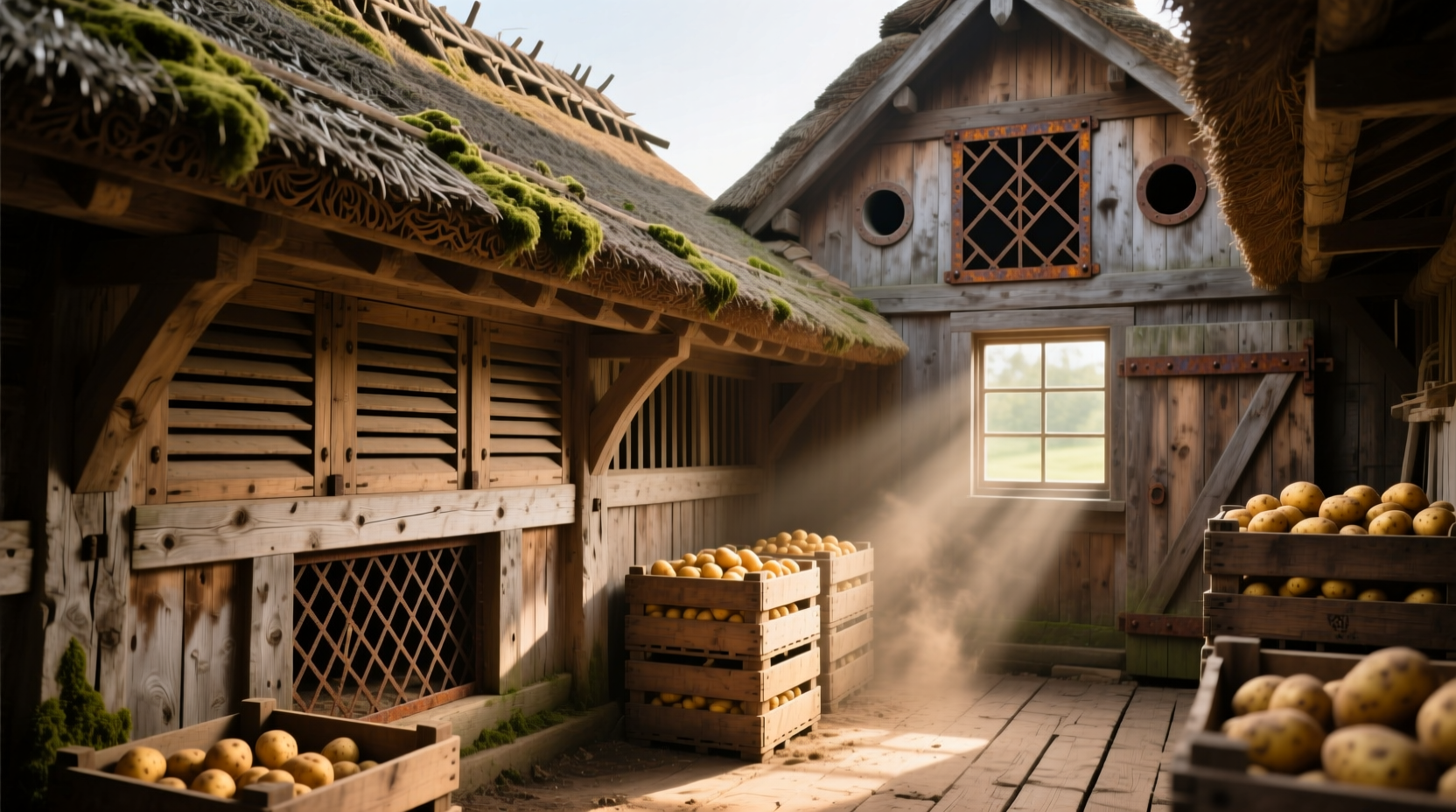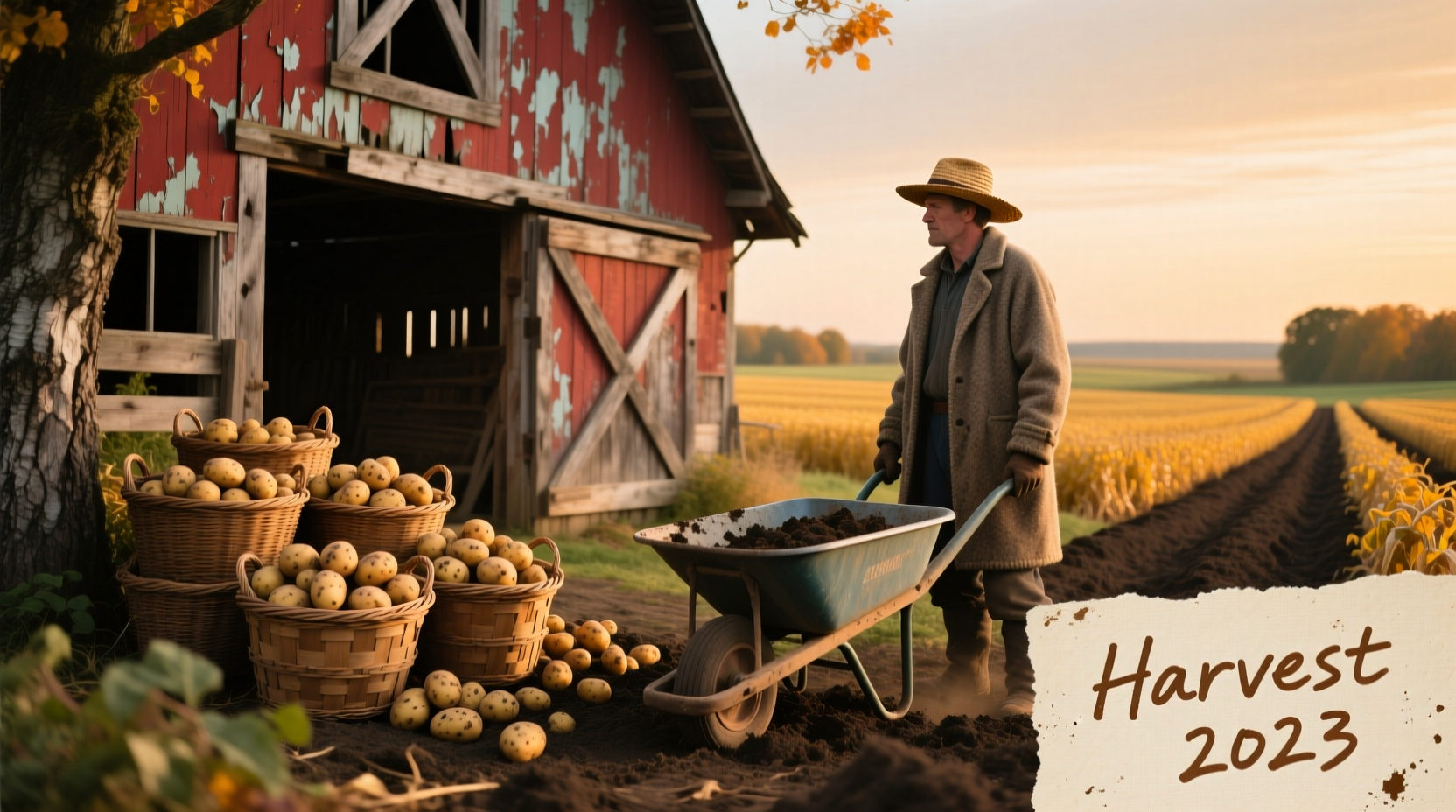Discover how traditional potato barns solve one of farming's biggest post-harvest challenges: keeping your potato crop viable through winter. Whether you're a small-scale gardener or commercial grower, understanding proper potato storage can prevent 30-40% post-harvest losses that commonly occur with improper methods.
The Critical Science Behind Potato Storage
Potatoes aren't just sitting dormant in storage—they're living organisms undergoing complex biochemical processes. The University of Idaho's Agricultural Extension research shows that at temperatures above 55°F, potatoes convert starch to sugar at alarming rates, while below 40°F, cold-induced sweetening creates undesirable flavors when cooked. Proper ventilation is equally crucial; without adequate air circulation, carbon dioxide buildup triggers premature sprouting.
| Storage Condition | Optimal Range | Consequence of Deviation |
|---|---|---|
| Temperature | 45-50°F (7-10°C) | Below 40°F: Sweetening; Above 55°F: Sprouting |
| Relative Humidity | 90-95% | Below 85%: Shriveling; Above 98%: Rot risk |
| Light Exposure | Total darkness | Even brief exposure: Solanine production (toxic) |
| Ventilation | 0.5-1 cubic foot/minute per cwt | Inadequate: CO2 buildup; Excessive: Moisture loss |
This precise environmental control isn't just helpful—it's essential for food safety. The USDA's Agricultural Research Service confirms that improperly stored potatoes develop solanine, a toxic compound causing nausea and headaches, at rates 200% higher than properly stored tubers.
Evolution of Potato Storage: From Traditional to Modern
Understanding how potato storage has evolved helps explain why modern potato barn designs work so effectively:
- Pre-1900s: Andean farmers used qullqas—stone storage pits with natural ventilation, maintaining stable temperatures through thermal mass
- Early 1900s: Wooden root cellars with straw insulation became common in North America and Europe
- 1940s-1970s: Concrete block storage facilities with basic ventilation systems emerged
- 1980s-Present: Climate-controlled potato barns with automated monitoring systems became standard for commercial operations
According to historical agricultural records from Cornell University's Mann Library, the transition from traditional root cellars to purpose-built potato barns reduced post-harvest losses from 60% to under 15% for commercial growers.
Practical Potato Barn Design Considerations
When planning your potato storage solution, consider these critical factors:
Size and Capacity Planning
Calculate your storage needs based on harvest volume. The National Potato Council recommends allowing 1.5 cubic feet per 50-pound sack to ensure proper air circulation. Overcrowding is the most common mistake among home growers, leading to hot spots and accelerated spoilage.
Essential Ventilation Systems
Effective ventilation requires both intake and exhaust systems. Small-scale operations can use passive ventilation with strategically placed vents, while commercial operations typically need mechanical systems. The University of Wisconsin's Potato Storage Guide specifies that air should move through the pile at 10-15 feet per minute for optimal results.
Temperature Control Solutions
For most small to medium operations, passive cooling through proper barn orientation and insulation suffices. North-facing windows (covered to block light) and thermal mass materials like stone or concrete help maintain stable temperatures. Commercial operations often require refrigeration units with precise thermostats.
When Potato Barns Aren't the Best Solution
While potato barns work exceptionally well for most storage needs, certain situations call for alternative approaches:
- Very small harvests (under 50 pounds): A basement corner with proper humidity control often suffices
- Short-term storage (under 2 months): Refrigerated crates work better for immediate consumption needs
- High-humidity climates: Additional dehumidification may be necessary to prevent rot
- Organic certification requirements: Some regions mandate specific construction materials
The Agricultural Marketing Resource Center notes that in regions with consistently warm climates (above 60°F year-round), modified shipping containers with climate control often prove more cost-effective than traditional potato barn construction.
Seasonal Management Calendar
Successful potato storage requires active management throughout the storage period:
- Harvest (August-October): Cure potatoes at 50-60°F with high humidity for 10-14 days to heal minor wounds
- Early Storage (November-December): Maintain 45-50°F; monitor for sprouting or disease
- Mid-Winter (January-February): Check humidity daily; add moisture if below 90%
- Late Storage (March-April): Gradually increase temperature to 50°F to prevent cold-induced sweetening before planting
Iowa State University's research shows that growers who follow this seasonal management approach extend their storage period by 30-45 days compared to those using static conditions throughout winter.
Avoiding Common Storage Mistakes
Even with a well-constructed potato barn, these common errors can ruin your crop:
- Mixing varieties: Different potato types have varying storage requirements—keep them separate
- Ignoring pre-storage curing: Skipping the 10-14 day curing period increases spoilage risk by 25%
- Poor ventilation planning: One-directional airflow creates dead zones where rot begins
- Inadequate monitoring: Daily temperature/humidity checks prevent small issues from becoming disasters
According to the American Journal of Potato Research, inconsistent temperature fluctuations account for 43% of storage-related losses in small-scale operations.

Modern Innovations in Potato Storage
Recent advancements make potato storage more accessible than ever:
- Wireless monitoring systems: Bluetooth sensors provide real-time data to your smartphone
- Natural antimicrobial treatments: Food-grade essential oils reduce rot without chemicals
- Modular storage units: Scalable systems grow with your production needs
- Solar-powered climate control: Sustainable temperature regulation for off-grid operations
The Potato Association of America reports that growers using modern monitoring technology experience 18% fewer storage losses than those relying on manual checks alone.
Practical Implementation Guide
Ready to implement proper potato storage? Follow this step-by-step approach:
- Assess your current harvest volume and storage needs
- Determine your budget and available space
- Choose between retrofitting existing structures or building new
- Install proper ventilation with both intake and exhaust points
- Implement temperature and humidity monitoring
- Establish a daily inspection routine
- Document conditions and crop response for continuous improvement
For immediate improvements to existing storage, the Cooperative Extension System recommends starting with a simple hygrometer and thermometer—these basic tools prevent 60% of common storage problems when checked daily.











 浙公网安备
33010002000092号
浙公网安备
33010002000092号 浙B2-20120091-4
浙B2-20120091-4